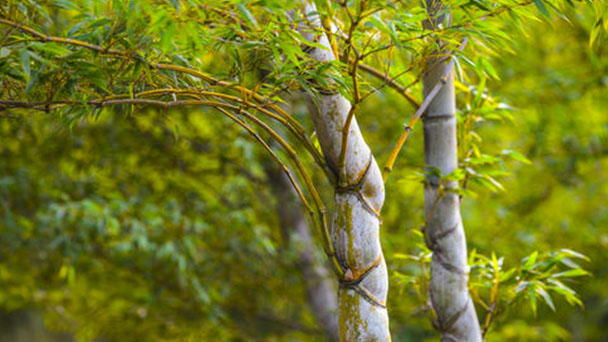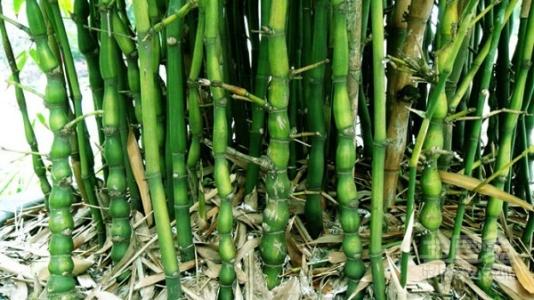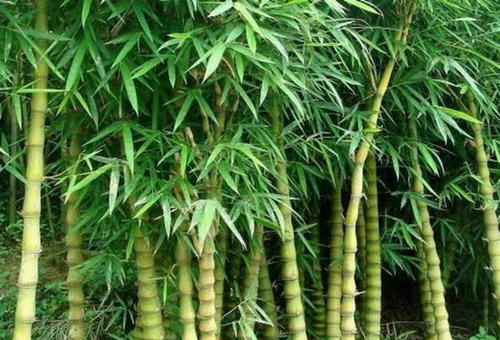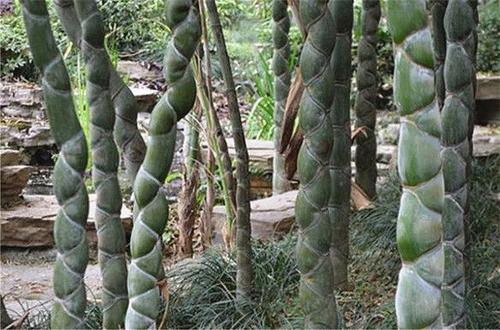Tortoise-shell bamboo (Phyllostachys edulis) profile
Written by Maggie
Mar 03 2021

Tortoise- Shell Bamboo, scientific name Phyllostachys edulis, also called mōsō bamboo, is easy to grow but difficult to propagate, and is very rare, and is a rare ornamental bamboo species in China. Compared with other clever and handsome bamboo, it is less delicate and elegant, and more strong and resolute. At the base of the culm and even a long segment of the culm, the internodes of the culm continue to shrink and swell irregularly, and the intersecting is continuous like a tortoise shell, which symbolizes longevity and health. The elegant and elegant bamboo of the culm is amazing in all shapes and forms.
Tortoise- shell bamboo picture

Morphological characteristics of tortoise- shell bamboo
Tortoise- Shell Bamboo is up to 20 m high, up to 20 cm thick, young rods densely pilose and thick white powder, sheath ring hairy, old rods glabrous, and from green to greenish-yellow; The basal internodes are very short and the ascending internodes are longer, the central internodes are 40 cm or more long, and the wall thickness is about 1 cm (but varies);Culm annulus inconspicuous, lower than culm sheath annulus or raised in slender rods. Sheath of Tortoise- Shell Bamboo is abaxially yellow-brown or purplish brown, with blackish-brown spots and densely brown prickles;Culm sheath auricles minute, tassels developed; Culm sheath tongue broad and short, strongly erect to acuminate, margin with coarsely long cilia; Culm sheaths are shorter, long triangular to lanceolate, undulate curved, green, erect at first, later valvate. Last branchlets of Tortoise- Shell Bamboo have 2-4 leaves; The auricles are not obvious, and the tassels on the mouth of the sheath are abscisic. Leaf blade of Tortoise- Shell Bamboo is smaller and thinner, lanceolate, 4 -- 11 cm long, 0.5 -- 1.2 cm wide, lower surface pilose along midrib base, secondary veins 3 -- 6 pairs, second veins 9.Branches spicate, 5-7 cm long, base supported by 4-6 progressively larger minute scaly bracts, sometimes with 1-3 nearly normally developed leaves below the branches, when the branches are terminal; Spathe is usually in more than 10 pieces, often be a side, a neat compound tile pattern, the lower number of infertility and early fall, lower part of the squid and similar flowers for the handle, the upper edge of cilia and fluff, leaves the ear, narrow leaves small, lanceolate to cone, within each child sex spathe with 1-3 spikelet. Spikelet of Tortoise- Shell Bamboo is with only 1 floret; Cob extending back to the lemma of the uppermost floret, needle-like, internodes pubescent; Tortoise- Shell Bamboo has 1 glume, 15-28 mm long, apex often with cone-shaped reduced leaves like spathe, lower, distal, and margin often hairy; Lemma of Tortoise- Shell Bamboo is 22-24 mm long, distally and marginally hairy; Lemma slightly shorter than its lemma, hairy above middle; Scales are lanceolate, ca. 5 mm long, ca. 1 mm wide; Filaments of Tortoise- Shell Bamboo are 4 cm long, anthers ca. 12 mm; Tortoise- Shell Bamboo has 3 stigma, feathery. Caryopsis is oblong, 4.5 -- 6 mm long, 1.5 -- 1.8 mm in diam., apically with a persistent style base.
The ecological habits of tortoise-shell bamboo
Tortoise- Shell Bamboo is positive, likes warm wet climate and fertile loose soil.
The distribution region of tortoise- shell bamboo
In the middle and lower reaches of the Yangtze River, south of the Qinling and Huaihe Rivers and north of the Nanling Mountains, moso bamboo forests are occasionally found.

Tortoise-shell bamboo garden use
The tortoise-shell-like bamboo poles are rare and rare, especially the taller ones, which are the treasures of bamboo.
Ornament garden, a few plants planted in the courtyard eye-catching place, but also potted ornamental.
The bamboo of Tortoise- Shell Bamboo can be used to make all kinds of advanced bamboo crafts. Such as engraving book couplet, especially belongs to elegant pin.
The growing methods of tortoise- shell bamboo
Tortoise-shell bamboo are transplanted to the mother bamboo cultivation. Dig the mother bamboo, to bring more soil, and with about 50 cm of bamboo whip. The genetic characters of Tortoise-shell bamboo are not very stable, the new bamboo grows smaller year by year after planting, and some bamboo poles become normal bamboo poles. It can be controlled by removing the non-dragon scale bamboo on the ground, preventing the growth of bamboo whip and strengthening the management of fertilizer and water.
Other cultivars of tortoise- shell bamboo
In addition to the Phyllostachys edulis 'Heterocycla', aka Tortoise Shell Bamboo, the species has a number of other known cultivars, or subspecies.
Phyllostachys edulis 'Bicolor': Buttery yellow with thick green stripes on alternating sides of the stems. Smaller in size and less cold tolerant than the original species, this is a rare and difficult variety to grow, but remarkably rewarding as well.
Phyllostachys edulis 'Subconvexa': An especially rare variety with even more tightly compressed nodes, still in the tortoiseshell pattern. Grows about 20-30 feet tall in China and Japan.
Phyllostachys edulis 'Nabeshimana': Also called ‘Tao Kiang’, this exotic cultivar produces some of the most exquisite coloration of any bamboo, with yellow and green candy-cane stripes running up and down the culms.

Latest Updated
- Benefits of Bugleweed - 7 Science-backed Health Benefits
- Bugleweed Dangers & Side Effects - Is It Poisonous?
- How to Plant Evergreen Trees - What You Should Know
- When to Plant Evergreens - Grow Guide for Evergreen Trees
- 12 Wonderful Evergreen Shrubs for Your Garden
- 12 Popular Evergreen Plants with Pictures for Beginners
- When And How To Prune A Lilac Bush Like a Pro
- How to Grow & Care for Lilac Vine (Hardenbergia Violacea)
- Japanese Lilac Tree (Syringa Reticulata) Care & Propagation Guide
- Shumard Oak Pros and Cons - What to Know
Popular Articles
- Winter maintenance of Antirrhinum Majus
- How to Grow Terminalia Mantaly Tree
- How to Grow and Care for Crossostephium Chinense
- How to grow Antirrhinum Majus in spring
- Peristeria Elata (Dove Orchid) Profile: Info & Care Guide
- Underwatered Snake Plant (Sansevieria Trifasciata) - Signs And How To Fix
- How to Care for Brazilian Jasmine Plant (Mandevilla Sanderi)
- How to Grow & Care for Graptopetalum Purple Delight in Summer
- Rosa Chinensis (China Rose): Plant Growing & Care Tips
- How to Care for Baby Sun Rose (Aptenia Cordifolia)